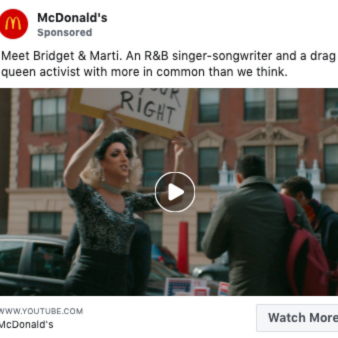Let's talk about something that's super important for your
business: identifying your ideal target markets for paid campaigns. I know, I
know, it might sound a bit boring, but trust me, it's crucial if you want to
get the most bang for your buck when it comes to advertising.
I hope you enjoy reading this blog post. If you want my team to just do your marketing for you, click here.
What's a Target Market, Anyway?
First things first, let's define what we mean by a "target market." Essentially, it's the group of people who are most likely to buy your product or service. Some of them might already be customers, while others may not even know you exist yet.
Now, you might be thinking, "Isn't that the same as a demographic?" Well, not exactly. Demographics are actually subsets of a target market. For example, let's say you're a car insurance company. Your target market could be "all car owners," but your latest marketing campaign might focus on a specific demographic within that market, like young drivers.
Why You Need to Identify Your Target Market
Picture this: you're running an ad campaign for your car insurance company, but you're using messaging and imagery aimed at young drivers in a social media campaign targeted at older audiences. Or, you're bidding on keywords like "car insurance for young drivers," but your actual target market is older motorists. Not the best strategy, right?
These might seem like obvious mistakes, but even small targeting missteps can cost you big time. The average cost per click (CPC) of a Google search ad is $2.69, but in some industries, it can be way higher. If you're in the legal sector, just 100 clicks could set you back $675. That's a lot of money to waste on the wrong audience!
And it's not just about the money. Google and Facebook use "quality scores" or "relevance scores" to determine where your ad ranks and how much you pay. If your ad is more relevant to your target audience than your competitor's, you could outrank them even if you're bidding the same amount. Pretty sweet, huh?
Target Audience for Organic vs. Paid Ads
Now, you might be wondering if there's a difference between an "organic audience" and a "paid audience." The truth is, we're all the same people; our online behavior just changes depending on where we are in the buyer's journey.
Let's use search as an example. Generally, people are less likely to click on paid listings than organic ones. But, paid listings actually beat organic listings 2:1 for keywords with high commercial intent. That means people clicking on paid ads are often more ready to buy.
How to Find Your Ideal Target Market
If you offer a niche product or service, like car insurance for young drivers, your target market is pretty straightforward. But if you have a diverse customer base or a mass-market product, things get a bit trickier. Don't worry, though; you can still narrow down your target market for PPC and paid social campaigns.
1. Look for Common Threads in Your Current Customers
Unless you're a brand new business, you already have a customer base that can provide valuable insights into your ideal target market. Even if your customers seem really different on the surface, they likely share some key characteristics, behaviors, or interests.
Consider things like:
- Age: Are they Baby Boomers, Gen X, Millennials, or Gen Z?
- Stage of life: Are they students, new parents, empty nesters, or retirees?
- Location: Where do they live? Are they all in the same region or time zone?
- Buying power: How affluent are they? Would they consider your product a major purchase?
- Interests: What do they like to do in their free time? Do they have favorite sports teams, music artists, or TV shows?
- Pain points: What problems are they trying to solve with a product like yours?
None of these factors will give you the full picture on their own, but together, they can help you target more effectively.
2. Figure Out Why People Buy From You
Okay, so you know who your customers are. Now you need to understand why they choose to buy from you.
People make purchases for all sorts of reasons, like:
- To meet a basic need, like food or shelter
- For convenience, like grabbing a coffee at the nearest shop when they're thirsty
- To replace or upgrade something, like trading in an old suit or buying a smart TV
- For aspirational reasons, like buying a fancy watch to impress others
- Because of peer pressure, like when their friends convince them to buy something
- To treat themselves, even if they don't really need the item
- To stay on trend, like waiting in line for the latest iPhone
- Because it's a great deal, like when a long-awaited product goes on sale
Sometimes, a purchase falls into multiple categories. A new car could be aspirational, a replacement for an older model, and more fuel-efficient all at the same time.
To figure out the main reasons people buy your product, try running a customer survey that asks things like:
- What made you look for this product in the first place?
- Why did you choose us over a competitor?
- What other factors influenced your decision?
- Was there anything that almost stopped you from buying?
3. Base Your Decisions on Data, Not Assumptions
Do you know the number one reason startups fail? It's not running out of money or pricing their product too high. It's having no market need for what they're selling.
This happens when business owners are so caught up in their own vision that they don't stop to see if anyone actually wants what they're offering. They make assumptions instead of looking at the data.
Don't make the same mistake. Never assume you know your target market and what drives them to buy without actually asking them. Use their responses to guide your marketing strategy, not just your gut instinct.
How to Use Your Target Market in Your Paid Ads
Now that you understand your target market, you can use that knowledge to inform your paid ad strategy.
1. Segment Your Target Market
Your research probably uncovered multiple subgroups within your overall target market. You could try to reach all of them with one generic campaign, but you'll likely see better results if you segment your audience and target each group with different ads.
McDonald's is a great example of this. They're trying to reach pretty much everyone, but they don't always use the same ads for all audiences. Check out these two McDonald's ads, both aimed at a young audience and related to social issues:

Almost half the audience for this ad was 18-24 year-olds. It's cool, inclusive, and links to YouTube, which has a huge reach with younger audiences.
2. Use Demographic Targeting
Platforms like Facebook and LinkedIn offer a ton of demographic targeting options for social ads, starting with basics like:
- Location
- Age
- Gender
But you can get way more specific. With Facebook Audience Insights, you can mix and match options to understand your target market's size and makeup.
For example, let's say you want to target people in the US interested in digital marketing. You can see a top-level breakdown of that audience. But if you narrow it down to men aged 25-34 in California with those interests, you might find they're:
- Almost all college-educated
- Mostly working in sales or production
- Interested in Gary Vaynerchuk and Tim Ferriss
- Nearly twice as likely to click ads as the average Facebook user
The more you know about your audience, the more you can learn. It's a virtuous cycle!
3. Exclude Certain Audiences from Paid Search Campaigns
Imagine this: you've done your research, segmented your target market, and created separate paid search campaigns with custom landing pages for each audience.
But there's a problem. People are clicking ads meant for other audiences and ending up on irrelevant landing pages. Instead of buying, they're bouncing right to your competitors.
Don't panic! You can fix this with audience exclusions. They let you:
- Stop targeting existing customers
- Exclude people better suited for a different campaign
- Remove website visitors who have already taken the action you wanted
To set up audience exclusions in Google Ads:
- Sign in to your Google Ads account
- Click "Audiences"
- Click "Exclusions"
- Click the blue "+" icon
- Choose "Campaign" or "Ad group" from the dropdown menu
- Click the pencil icon and select the campaign or ad group
- Use "Search" and "Browse" to find the audiences to exclude
- Click "Save"
FAQs
1. How often should I reassess my target market?
It's a good idea to revisit your target market regularly, especially if you're launching new products or services, expanding into new areas, or noticing shifts in your customer base. At a minimum, aim to review your target market annually.
2. What if I have multiple target markets?
That's totally normal! Many businesses have several distinct target markets. The key is to develop separate marketing strategies and campaigns for each one, rather than trying to reach them all with a one-size-fits-all approach.
3. Can I target different markets on different platforms?
Absolutely! Different social media platforms and advertising channels tend to have different user demographics. For example, Instagram tends to skew younger than Facebook, while LinkedIn is geared toward professionals. Tailor your platform strategy to where your target markets spend their time online.
4. How do I know if I've chosen the right target market?
The proof is in the pudding, as they say. If your campaigns are performing well and you're seeing strong ROI, that's a good sign you're targeting the right people. If not, it's time to revisit your target market definition and make some adjustments.
The Bottom Line
Identifying your ideal target market takes some time and effort, and it might be tempting to skip this step in the rush to launch your paid campaigns.
But trust me, it's worth it. When you really understand your target market, you'll reach more of the right people, convert more leads, generate more sales, and waste less money on ineffective campaigns.
 Add Row
Add Row  Add
Add 







